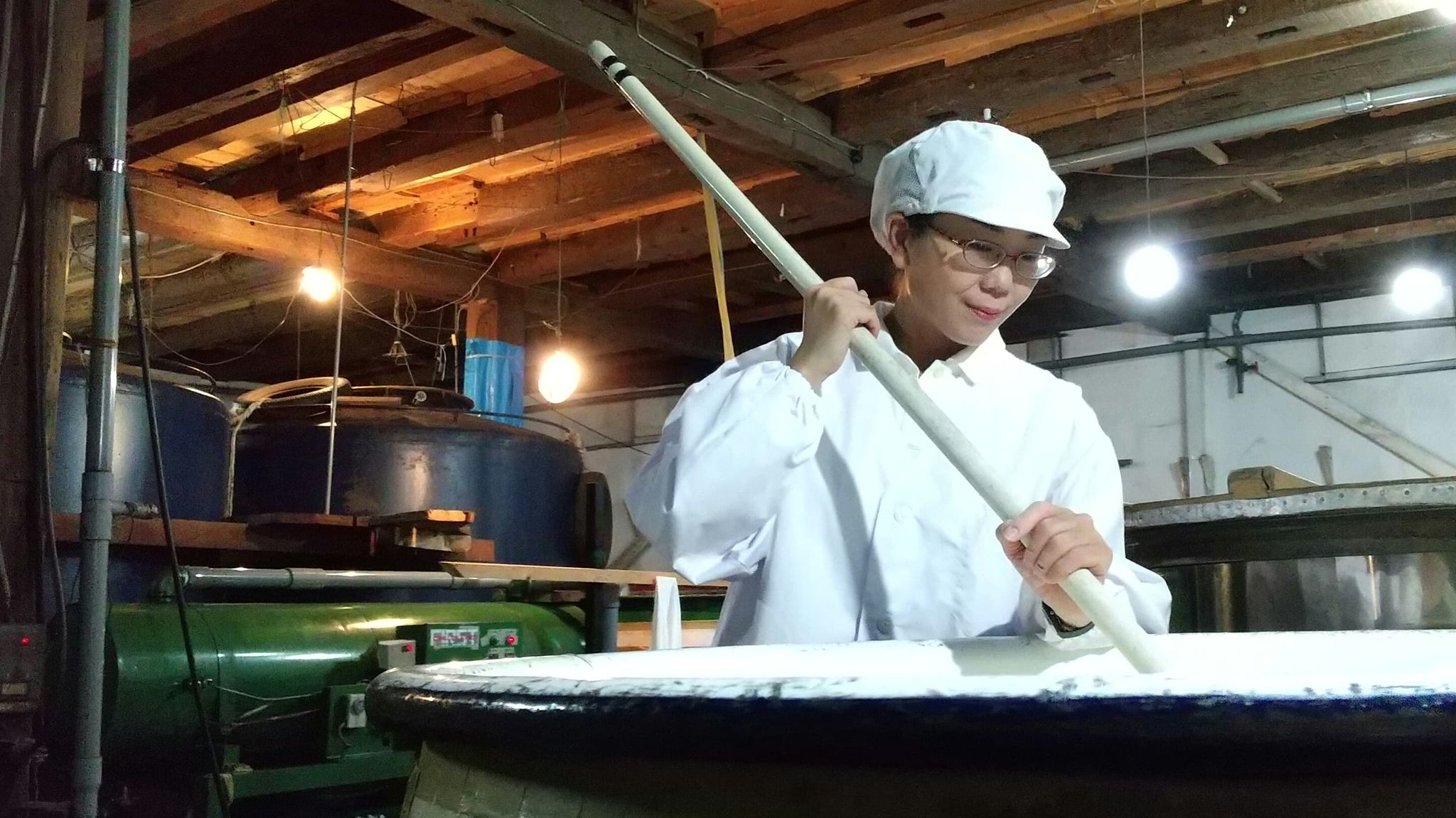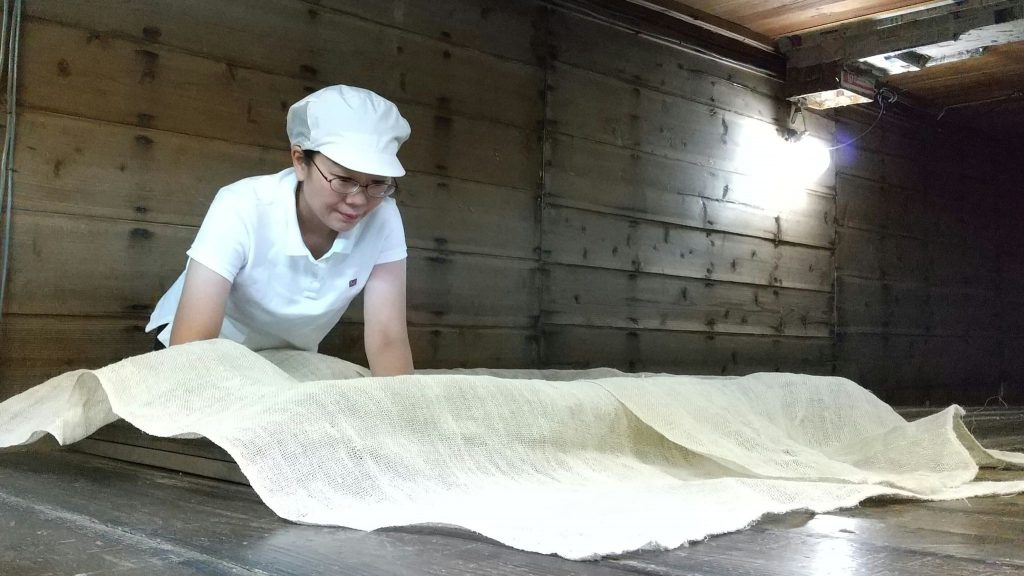
Sake Review – Watanabe Shuzojo and the Tale of Snow White
After joining a virtual Sake Lovers brewery tour and tasting of Watanabe Shuzojo, I was given an interesting opportunity to talk with the toji (brew master) about the brewery and one of its newer sakes, along with a light-hearted connection to an age-old fairytale.
Once upon a time…
Watanabe Shuzojo is located in Ogaki, Gifu Prefecture, about an hour’s drive from Nagoya city. Founded in 1902, the brewery started under an Echigo (Niigata) guild toji and would thereafter refine and tailor its sake to reflect the local tastes and flavors of its food and the uniqueness of its community.
There was a remarkable young woman.
Four generations later, Asako Watanabe stepped up to take over the kaibou (oar-like sake stirring paddle) as the first and still only female toji in Gifu Prefecture. Watanabe tells the story of how the father of three daughters looked to her to continue the family business after her two sisters wed and moved away.
After graduating from the esteemed Tokyo University of Agriculture, Watanabe first gained brewing experience with another brewery, before returning home to put her passion into developing an excelling lighter sake style to complement their flagship label “Minonishiki,” which is high in umami with underlying aged flavors.
She worked very hard.
As toji, Watanabe explains heavy muscle work is not required, rather the craftsmanship to balance the complex and delicate micro-organic processes from start to end. Brewing every season, the toji needs to pay close attention to the rice harvest, as the product quality differs depending on climatic conditions. This affects all downstream activities from moisture absorption before/during steaming, koji culturing, starch to glucose conversion speed, etc. Watanabe remarks that this is where she gets great personal satisfaction.
The most physical hardship she recalls was on many occasions recovering from the flu because her body wasn’t accustomed to the large fluctuations in temperature between the brewery’s winter air and the warm, humid kojimuro (koji mould culturing room). She would frequently visit the kojimuro alone throughout the evening to “babysit” the koji. Frankly, I imagine many men would also be susceptible.

Her talent was quite rare.
You might be wondering how many female toji are in Japan? Watanabe believes there are between 20-30. And, how many sake breweries are there in Japan? There are 1,700 registered breweries as of June 2019, according to a National Tax Agency (NTA) report(page 5, unfortunately only in Japanese as there are lots of weird and nerdy statistics on the NTA, the gatekeepers of the alcohol tax revenues).
The sadder tale is that only around 1,200 are so-called “active”! Another sign this industry had seen better days. So, if there were say 25 female toji, they would represent just 2 percent of toji across active breweries. However, we expect this to increase, albeit slowly.
She cherished local traditions.
Watanabe Shuzojo produces 18 kiloliters
annually. It doesn’t sound like much. In fact, it isn’t according to another NTA report(page 9) on production volumes of filtered/refined sake (seishu legally covers
premium and regular sake categories) broken down by brewery sizes. As of June
2019:
– 723 of 1,144 breweries (65 percent) produced 100 kiloliters or less.
– 899 of 1,144 breweries (80 percent) produced 200 kiloliters or less.
– Only 11 breweries (1 percent) produced over 5,000 kiloliters
The staggering reality is that one percent of the total number of breweries collectively produce about half of the total sake volume. The sake market is indeed an interesting one and there are many interesting statistics. While Watanabe’s brewery may be a dwarf among its peers, I personally felt Watanabe is on a mission deserving of notice. The brewery uses only traditional manual processes with a focus on premium sake (tokutei meishoshu). With only three brewing workers during the winter season, I feel certain Watanabe must be pulling more than her small weight! There is also an interesting read about Watanabe and her doburoku (not legally seishu though) in another post on Sake Geek.
She lived in a magical place.
I found it interesting that Tokugawa Ieyasu opportunistically saw the strategical military value of the location of Ogaki and developed it into a castle town in the late 16th century. In 1600, Tokugawa took victory at the famous Battle of Sekigahara to lay the foundation for the Tokugawa Shogunate and bring peace to the nation after 150 years of feudal warring.
Ogaki even back then was renowned for its mineral spring waters. Today, Ogaki is still called the “capital for water” (Mizu-no-miyako 水の都). The geographical area is one of Japan’s leading artesian aquifers with the nearby mountains receiving high annual rainfall even for Japan. Watanabe comments that Ogaki water is ideal for brewing sake due to its medium-soft qualities. The brewery has also recently started to lorry-truck quantities of natural spring water from the nearby Mount Koga for its softer (less mineral) qualities. Watanabe considers this to better suit the brewing of their daiginjo sakes.
On the important subject of rice, the brewery uses sake specific rice varieties of Yamadanishiki, Gohyakumangoku, and Hidahomare. Hidahomare is the only sake specific rice grown in Gifu Prefecture in significant quantities (>100 tonnes annually) and seems favored by Gifu brewers not just because the rice is well adapted to the local environment and in abundant availability.
She cared about her land.
Seeking increased collaboration with the local community, the brewery selected a popular locally grown table rice variety called Shirayukihime, which translates in English to “Snow White” (let’s go with the latter since it will be easier to read and type). Snow White was developed in the prefecture’s “Gifu Clean Agriculture” campaign to promote ecologically friendly products. The rice grain is reportedly large, healthier for human consumption, disease resistant, needing less pesticide and fertilizers, etc. and it was very delicious when cooked. There were even rice farmers who raised ducks on their farms to further reduce the need for pesticides. Sounds like a fairytale?
The brewery refined its brewing techniques using Snow White and everyone lived on happily. Not for long, however, since Snow White became difficult to source because farmers started to prefer growing other popular (undoubtedly, more economical) varieties which left the brewery searching for a replacement. The hero was another locally popular Hatsushimo (First Mist, named so because of its late harvest when mist would appear) table rice which shared many of the strong traits of Snow White. First Mist today represents about 30 percent of Gifu’s total harvested rice, so it is in abundant supply. The name Snow White however stuck as the target sake style had not changed.
Watanabe explains while First Mist is slightly more glutinous than average table rice, it is not sticky and particularly popular for sushi rice. First Mist has large soft grains which help to resist cracking even under the high 50 percent polishing required for daiginjo.
She created the fairest of them all.
Shirayukihime Daiginjo is fully made from Hatsushimo table rice polished to 50 percent. Rice is typically steamed in small 200-400 kilograms batches for one hour. Regular yellow koji fungus is used to culture the koji rice which is transferred into small hako-koji (wooden boxes holding 15 Kg of rice) to carefully and evenly culture a tsukihaze (light) mould growth suited to ginjo fermentations. Gifu’s G2 yeast is used. G2 was only developed over five years ago and acclaimed for drier sake styles having distinct apple aromas. The softer Mount Koga spring water is used in the moromi (main mash) where a cool fermentation, at around ten degrees centigrade, is managed over a four-week period.
Temperature control is by manual adjustment of the ice water flowing through cooling mats covering the moromi tank. Before the main filtering, Watanabe adds brewers alcohol to bring out the flavor sharpness and the sake is finally diluted with water to bring the final product to 15 percent abv. I learned that the daiginjo can be stored for as short as only one to two weeks before being once-pasteurized at bottling for immediate release. Watanabe’s goal is to brew a smooth tasting sake that goes well with food and pays less emphasis on the aroma.
How can table rice compare favorably against sake specific rice when producing daiginjo? Watanabe responds that while table rice has no clearly visible shinpaku (concentrated white starch center which is a key characteristic in sake specific rice), breweries are better at extracting the most from top quality table rice (brewery’s First Mist is First Grade) due to technological advancements with machines when it comes to rice polishing and washing. During the virtual tour, Watanabe points out the brewery’s only machine is for rice washing and gratefully saves many laborious hours daily washing rice with gloved hands in freezing water! The water jet flows can consistently mimic the effectiveness of hand washing to completely remove all residual nuka (rice bran) before rice steaming.
She lived happily ever after.
Shirayukihime Daiginjo appearance is clear, lemon-green in color with pale intensity. I pick up aromas of rice and the taste of green apple with medium dryness and low umami. It is indeed a pleasant drinking sake with light flavored meals and I found enriched satisfaction finishing off the bottle with soft mild cheeses. Watanabe recommends this sake pairs really well with the local Ayu (fresh river trout). I definitely need to travel there to experience that as well. The end.
Brewer: Watanabe Shuzojo, Hayashimachi 8-1126, Ogaki, Gifu Prefecture
Sake reviewed: Shirayukihime Daiginjo (白雪姫大吟醸) 製造日: Nov-2019
https://minonishiki.com/ (No English web content)
Interesting side facts.
- The brewery has five labels producing 11 sake varieties; apart from the daiginjo, Shirayukihime is also sold in ginjo and ginjo namagenshu styles. Accept small group tours in Japanese by reservation.
- Ogaki City is home to 3 of 50 breweries in Gifu Prefecture.
- The Ogaki Castle keep was designated a National Treasure in 1936 because of its special role in the famous Battle of Sekigahara. After being destroyed in WWII bombings, the castle keep was rebuilt in 1959 and serves as a museum.





